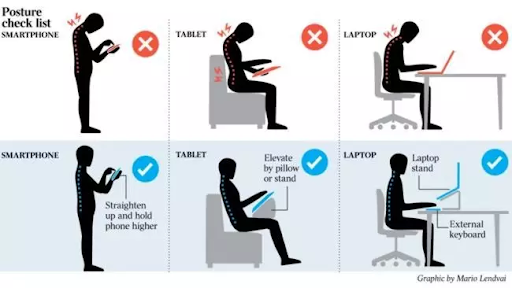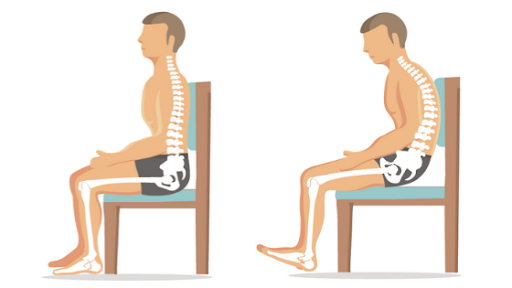The Internet is Killing Your Posture

"A good stance and posture reflect a proper state of mind -Morihei Ueshiba"
DON’T MOVE.
Whether you’re reading this on your phone or computer, picture and visualize how your posture is RIGHT NOW.
Not the best, right?
In a study done by the American Chiropractic Association, over 31 million Americans suffer from poor posture at any one time (1).
Prolonged device usage causes faulty posture including, forward neck posture, slouched posture, and/or rounded shoulders.
So basically, you're setting yourself up to look like this:

This is a life-sized model named "Emma" which was created by Fellowes and Behavioural Futurist William Higham, to illustrate how office workers may look in 20 years' time.
You may even know someone that looks like this right now.
Are you suddenly sitting up straight after seeing that? Me too.
Sustained forward neck posture can cause injury to the structure of the cervical and lumbar spine, as well as other ligaments (2).
One study found a “statistically significant association between trunk asymmetry and the average daily duration of computer use. Specifically, early adolescents who used a computer for an average daily duration of less than 1 hour to over 4 hours were found to be 1.63 times more likely to have trunk asymmetry than those who did not use a computer” (3).
In short, those who were on their computers the longest were found to have a higher risk of poor posture.
Pretty scary finding and that was only in adolescents.
It was also mentioned that daily screen time duration exceeding 2.5 hours a day is significantly associated with a lower quality of life and a range of other negative health outcomes.
Uhhh, no thanks.
Why Should You Care?
Well, as mentioned above, poor posture can be bad for your health!
Slouching or slumping over can:
- Misalign your musculoskeletal system
- Wear away at your spine, making it more fragile and prone to injury
- Cause neck, shoulder, and back pain
- Decrease your flexibility
- Affect how well your joints move
- Affect your balance and increase your risk of falling
- Make it harder to digest your food
- Make it harder to breathe

I’ve been around healthcare for a while now and I constantly see patients and clients coming in with a plethora of neck and back problems.
I can only think that it can be attributed to their terrible habit of bad posture.
Obviously, other indications may be the reason for their injuries as well, however, the way individuals sit and stand at work and out in public doesn’t do them justice.
Looking at the cervical spine, when the degree of flexion, i.e. bending head forward/down increases. The force transmitted to the cervical spine increases.
This increased force has the ability to cause increased pain. If the neck continues to be in an improper position for long periods of time, some muscles remain in their stretched positions while others in their contracted positions.
This can cause an imbalance that could also lead to pain and dysfunction. Maintaining good posture with prolonged use of your phone or computer can help limit or prevent potential neck and shoulder pain.

What “good posture” looks like:
Before we get into ways we can prevent bad posture, we must realize what “good posture” looks like.

On the left is a diagram of “good” posture, while the right is a diagram of “poor” posture while sitting.
Good posture involves:
- Shoulder blades retracted back and down
- Spine is straight and not flexed down
- Neck is pulled back with chin tucked in (a Physical Therapist I used to work with always said, “pretend like your best friend had garlic for lunch)
Here’s a picture of what “tucking your chin” looks like:

How to Prevent Poor Posture While Sitting: (4)
1. Fix Your Computer Set-up
For those of you who spend extended periods of time on the computer, having proper computer setup is essential.
The first step is to keep the monitor at or above eye level.
This allows you to keep your cervical spine at a neutral or slightly extended position, which prevents a forward, hunched posture that we do not want.
Next, you should move your seat up or down until your legs are parallel with the ground and your knees are even with your hips. Your arms should be parallel to the ground, too.
You should also make sure your body weight is distributed evenly across your hips. Bend your knees at a right angle, and make sure your knees are either even with your hips or slightly below.
Your feet should be flat on the floor, however, you may use a footrest if that’s not possible.
This allows proper alignment of your hips while sitting, to prevent any problems in the future. (refer to the diagram above for proper posture)
Lastly, leave 4 to 6 inches between the edge of your keyboard and the desk so your wrists have room to rest while you type.
If your keyboard is tall and you must tilt your wrists at an awkward angle to type, look for a padded wrist rest.
2. Take Brief Breaks Often
Being able to get up from a sitting position while sitting at home or in the office is essential to reduce the risk of atrophy in our muscles.
Taking breaks from prolonged sitting – or standing – can be beneficial to preventing fatigue in your muscles.
Imagine sitting for 8+ hours a day with little to no breaks… You’ll end up with the dreaded “office butt” years later.
I don’t think having a rear end that looks like Kermit the Frog is on anyone’s “bucket list”.
3. Make Sure Your Back and Legs are Supported
To save your lower back from some misery, use a back pillow or other back support if your chair does not have a backrest that can support your lower back's curve.
You should have a well-padded seat, and your thighs and hips should be parallel to the floor. You should also prevent your feet from swinging.
How to Prevent Poor Posture While Standing: (5)
Having proper posture while standing is just as important. Here are some tips for maintaining proper posture while standing:
- Stand up straight and tall
- Keep your shoulders back
- Pull your stomach in
- Put your weight mostly on the balls of your feet
- Keep your head level
- Let your arms hang down naturally at your sides
- Keep your feet about shoulder-width apart
How to Prevent Bad Posture While Using Your Phone:
The tips stated above can be utilized during any daily task, however, phone use is prevalent more than ever nowadays.
Here are some tips for preventing bad posture, specifically during phone use:
- Stand or sit upright, don’t slouch or slump
- Keep the phone at eye level.
- Minimize the amount that the arms are floating in front of the body.
- Find a place to rest your elbows: use the opposite hand, ribs, a desk and knees as possible options.
- Use phone’s voice dictation instead of texting
In the end…
Having proper posture should be of everyone’s utmost priority while performing day-to-day tasks. Neglecting to do so will ensure chronic injuries to your body down the line. Using the tips above can prove useful when trying to reduce the risk of poor posture.
TL;DR
- Sustained forward neck posture can cause injury to the structure of the cervical and lumbar spine, as well as other ligaments.
- Improper posture can also cause an imbalance of the structure of the body which could also lead to pain and dysfunction.
- Maintaining good posture – using the tips above – during prolonged use of your phone or computer can help limit or prevent potential neck and shoulder pain.
Good luck and #KEEPPLUGGIN
🙇🏻♂️🌱 Until Next Time, C.



